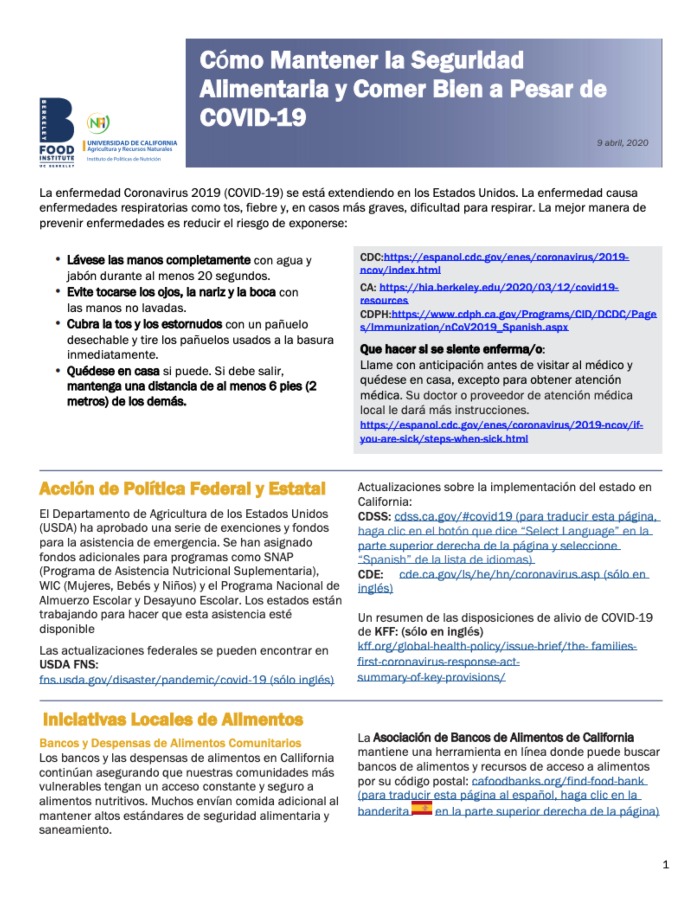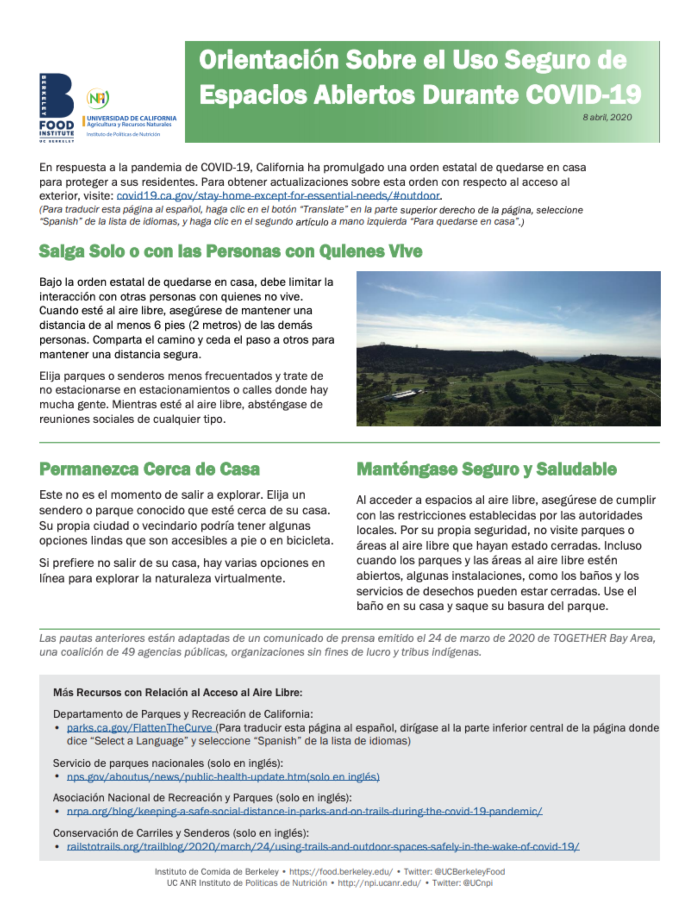This page was last updated on October 11, 2020.
We have stopped updating this page, so please be aware that it may not contain the latest information available on this topic.
Content managed by Danielle Lee (dnilee@ucanr.edu).
Coronavirus disease 2019 (COVID-19)
|
Coronavirus disease 2019 (COVID-19) is spreading in the United States. The disease causes respiratory illness such as cough, fever, and in more severe cases, trouble breathing. For the latest updates, please visit these website:
The best way to prevent illness is to reduce your risk of being exposed:
What to do if you feel sick: Call ahead before visiting the doctor and stay home except to get medical care. Your doctor or local health care provider will instruct you further. For more information, please visit the CDC website. COVID-19 resources in other languagesThe COVID-19 Health Literacy Project has fact sheets in 35 languages. All of the materials are reviewed and vetted by physicians and medical school faculty members at the Harvard Medical School hospitals. https://covid19healthliteracyproject.com/#languages Recursos en EspañolInformación sobre el coronavirus (COVID-19): https://hia.berkeley.edu/2020/03/12/covid19-resources/ |
Learn how UC ANR has worked to improve the lives of Californians despite COVID-19 in this video. Resources for UC Cooperative Extension County Advisors and Directors
|
How to Stay Food Secure and Eat Well Despite COVID-19
[This information is available as a printable fact sheet in English and Spanish]
Food & Food Systems Resources from the CDC
- The California state government has compiled resources for individuals and families seeking food assistance during the COVID-19 pandemic.
- The CDC has compiled additional resources on food assistance for individuals and families, and guidance for food assistance programs and food system stakeholders.
Federal & State Policy Action
The United States Department of Agriculture (USDA) has approved a number of waivers and funds for emergency assistance. Additional funding has been allocated for programs such as SNAP (Supplemental Nutrition Assistance Program), WIC (Women, Infants, and Children), and the National School Lunch and School Breakfast Program. States are working to make this assistance available.
Federal updates can be found at USDA Food and Nutrition Services.
Updates on state implementation in California:
A summary of COVID-19 relief provisions is available from the Kaiser Family Foundation.
Other Policy Resources
- Food Research Action Center
- California Food Policy Advocates
- The Education Trust
- Municipal COVID-19 Food Access Policies (Healthy Food Policy Project)
- Child and Adult Care Food Program Roundtable
- National Women, Infants and Children (WIC) Association
- COVID-19 and Food Law (UCLA's Resnick Center for Food Law and Policy)
Local Food Initiatives
School Nutrition Services
Even while schools are closed, many districts are continuing to provide meals to students. Meals are often distributed through a variety of grab-and-go formats for children in grades pre-K through 12. Meal service may vary by location, but all sites will provide free meals to children and many may offer meals for the weekend for pick-up on Friday.
- Meals for Kids interactive web map (USDA) is available online in both English and Spanish and lists school sites across the nation offering free meals for kids during COVID-19 closures.
- California Meals for Kids mobile app (CDE) is available for download for iPhone, Android and Windows devices and lists sites offering free meals for kids in California. Use the Emergency Meal Sites section due to COVID-19 school closures.
Pandemic EBT. Children who are eligible for free or reduced-price meals at school will get extra food benefits. These food benefits are called Pandemic EBT or P-EBT benefits. P-EBT benefits help families in California buy food when schools are closed because of the coronavirus emergency. Families will get up to $365 per eligible child on their P-EBT card to use on food and groceries.
School meal services. The Nutrition Policy Institute and Stanford Medicine Department of Pediatrics developed fact sheets on how California and national school districts can serve meals during the regular school year and over spring and summer breaks during COVID-19.
-
Back-to-School: We'll Keep Feeding Those Kids! [fact sheet]
-
Spring break - California school districts [fact sheet] [modifiable template]
-
Spring break - National school districts [fact sheet] [modifiable template]
- Summer break - California school districts [fact sheet] [modifiable template]
Community Food Banks and Food Pantries
Food banks and food pantries across California are continuing to ensure that our most vulnerable communities have consistent and safe access to nutritious food. Many are sending out extra food while maintaining high standards of food safety and sanitation.
The California Association of Food Banks maintains an online tool where you can search for food assistance by your zip code.
Buying Directly From Local Farmers and Ranchers
California farmers are selling to their local community members directly with on-line sales, CSAs, and pick-up and delivery services. Click below for more information:
- North Bay Area
- South Bay, Peninsula & San Francisco Area
- East Bay Area
- Central Coast Area
- Sacramento Valley & Foothills Area
- Southern California
Resources for Food Supply and Agriculture
Food Safety & Health
Before preparing or eating food, it’s important to practice frequent and thorough handwashing. Other practices, such as cleaning and disinfecting countertops and other surfaces can also serve as protection to you and others.
Although questions have been raised regarding the transmission of COVID-19, there is currently no evidence to suggest that it can be transmitted through food or water systems, but sharing food and beverages is discouraged. Proper home food safety is advised, including promptly refrigerating foods, keeping raw and cooked foods separate, and heating food to the appropriate temperature.
It is important to remember:
- Wash your hands with soap and water for a minimum of 20 seconds.
- Potable tap water is safe. You can use and drink tap water as usual.
Food safety and health resources:
- Fact Sheet: Is it safe to eat fruits and vegetables? (NPI, UCSD, Ideas42) Available in Spanish.
- CDC Food Safety Resources
- Food and Drug Administration (FDA) Food Safety and Availability During the Coronavirus Pandemic
- UC Davis COVID-19 Food Safety Resource
- Eat Right (Academy of Nutrition and Dietetics) coronavirus resources
Grocery Stores, Farmers Markets & Shopping
Grocery stores and many farmers markets will remain open and stocked throughout the state-wide stay-at-home order. There is no need to stockpile grocery items or household goods. You should only buy what you need.
However, many locations have adjusted their hours and operations. Some have designated priority shopping hours for seniors. Many have also limited the number of individuals allowed inside at one time or have increased spacing between vendors. When waiting in line to enter please maintain a distance of at least 6 feet from other individuals.
It is important to remember:
- Only buy what you need. Grocery stores and many farmers markets will remain open and stocked.
- Disinfect your shopping cart or basket. Many stores are providing disinfecting wipes on-site.
- Maintain at least 6 feet of distance from others while in the store or at the market.
To find a farmers market near you, check out this interactive map which also lists which markets accept EBT and participate in Market Match. Market Match is California’s healthy food incentive program, which matches customers’ federal nutrition assistance benefits, like CalFresh and WIC, at farmers’ markets.
Other Resources
Specific information for pregnant and breastfeeding women can be found below:
- Q&A on COVID-19, pregnancy, childbirth and breastfeeding (World Health Organization)
- COVID-19 and Breastfeeding (CDC)
Specific information for those caring for children can be found below:
Recommendations for healthy eating and high-risk populations:
- Stocking a healthy pantry and fridge (UCSF)
- Tips for stocking and eating fruits & vegetables (UCSF)
- Eating healthy for diabetes during COVID-19 (UCSF)
- Eating healthy for high blood pressure during COVID-19 (UCSF)
Additional resources for a healthy lifestyle:
- Resources to maintain healthy lifestyle amidst COVID-19 outbreak (American Heart Association (AHA))
- Working out while staying safe during the coronavirus (AHA)
Disaster relief assistance is available for immigrants living in California:
- COVID-19 disaster relief for immigrants (CDSS) - an undocumented adult who qualifies can receive $500 in direct assistance, with a maximum of $1000 in assistance per household.
This website is available in other languages. Click on the drop-down menu in the upper right corner of the page to select a new language. - California's Coronavirus Food Security Efforts for Immigrant Californians (California Food Policy Advocates)
Guidance On The Safe Usage of Open Spaces During COVID-19
[This information is available as a printable fact sheet in English and Spanish]
In response to the COVID-19 pandemic, California has enacted a statewide stay-at-home order to protect its residents. For updates on this order as it applies to outdoor access, please visit: https://covid19.ca.gov/stay-home-except-for-essential-needs/#outdoor
Go Solo Or With Your Household
Under the statewide stay-at-home order, you should limit interaction with others not in your immediate household. When outdoors, be sure to maintain a distance of at least 6 feet from others. Share the trail and yield to others to maintain a safe distance.
Choose less frequented parks or trails and try not to park in crowded parking lots or shoulders. While outdoors, please refrain from social gatherings of any kind.
Stay Close To Home
This isn’t the time to go exploring. Choose a familiar trail or park that is near your home. Your own city or neighborhood might even have some amazing options that are accessible on foot or by bicycle.
If you would prefer to not leave your home, there are several options online to explore nature virtually.
Stay Safe And Stay Healthy
When accessing outdoor spaces, be sure to abide by the restrictions set by local authorities. For your own safety, do not visit parks or outdoor areas that have been closed. Even when parks and outdoor areas are open, some facilities such as restrooms and waste services may be closed. Please use the restroom at home and pack out your trash.
The above guidelines are adapted from a press release issued on March 24, 2020 from TOGETHER Bay Area, a coalition of 49 public agencies, non-profits, and Indigenous Tribes.
More Resources Regarding Outdoor Access
- Centers for Disease Control and Prevention
- California State Parks COVID-19 Resource Center (California Department of Parks and Recreation)
- National Park Service
- National Forests (USDA Forest Service)
- California Bureau of Land Management (US Department of the Interior)
- Keeping a Safe Physical Distance in Parks and on Trails During the COVID-19 Pandemic (National Recreation and Park Association)
- Using Trails and Outdoor Spaces Safely in the Wake of COVID-19 (Rails to Trails Conservancy)
These resources were compiled in collaboration with the Berkeley Food Institute, Stanford Medicine Department of Pediatrics, UC Sustainable Agriculture Research and Education Program, UCSF Center for Vulnerable Populations, UC Berkeley California Outdoor Engagement Coalition, and UCCE Plumas-Sierra Counties.
California County Websites Dedicated to the Coronavirus
Visit the links below for COVID-19 resources compiled by each California county, compiled by the California State Association of Counties.
Flyers
How to Stay Food Secure and Eat Well Despite COVID-19 [Fact Sheet]
Cómo Mantener la Seguridad Alimentaria y Comer Bien a Pesar de COVID-19
[Hoja de hechos]
Guidance on the Safe Usage of Open Spaces During COVID-19 [Fact Sheet]
Orientación Sobre el Uso Seguro de Espacios Abiertos Durante COVID-19 [Hoja de hechos]

![[UCANR] Food Security and COVID-19_v2[1]_Page_1 [UCANR] Food Security and COVID-19_v2[1]_Page_1](http://ucanr.edu/sites/NewNutritionPolicyInstitute/files/322827display.jpg)

![[UCANR] Food Security and COVID-19_v2[1]_Page_3 [UCANR] Food Security and COVID-19_v2[1]_Page_3](http://ucanr.edu/sites/NewNutritionPolicyInstitute/files/322851display.jpg)
